When a key leader leaves, many organizations panic, putting workflows and strategic goals at risk. Succession planning flips the script: by growing internal talent, you’re always ready for smooth transitions.
Swap scattered spreadsheets for a single, flexible platform that keeps your plans on track. This guide highlights the must-have features, implementation tips, and top software to help you build a future-ready leadership pipeline.
Try monday work managementWhat is succession planning software?
Succession planning software provides a strategic framework for ensuring leadership continuity. It helps you pinpoint and cultivate the next generation of leaders, guaranteeing your organization is always prepared for change. This technology elevates the process from a confusing tangle of spreadsheets and disconnected files into a unified, strategic command center for your talent.
This approach is about building a deep bench of leadership talent, not merely maintaining a list of potential replacements. The right platform constructs visible development pathways for high-potential employees, proactively identifying and addressing skill gaps before they can impact the business. The core principle is to get ahead of leadership transitions, not just react to them.
Without a centralized system, succession strategies often devolve into a collection of hopeful guesses, leaving an organization vulnerable to disruption. This software consolidates critical data, converting reactive scrambling into a proactive strategy that ensures your business moves forward with confidence, regardless of the changes that arise.
What is a 9-box grid in succession planning?
The 9-box grid is a classic talent management tool that visually maps employees according to their current performance and future potential. Picture a simple 3×3 matrix: one axis measures performance (low, medium, high), while the other measures potential. This creates nine “boxes,” each representing a different combination of talent readiness.

Succession planning teams use the 9-box grid to quickly spot high-potential future leaders (top-right box), identify employees ready for immediate advancement, and highlight where skill-building or support is needed. It’s a fast, at-a-glance way to guide development conversations and prioritize the next generation of leadership.
Why succession planning matters for organizations
The departure of a key player can easily scatter workflows and halt organizational momentum. Imagine a scenario where, instead of scrambling to fill that void, your team already has a defined, actionable game plan ready to execute.
This is the essential value of succession planning. It centers on building a strong bench of internal talent, enabling you to transform a moment of significant change into a seamless handoff. This approach not only keeps projects on track but also reinforces team confidence. It moves beyond simple disruption avoidance to create a culture of readiness, where your team is equipped to adapt and maintain its competitive edge.
Keep your momentum during any transition
A robust succession plan ensures you remain one step ahead, with internal talent prepared to step into critical roles. This strategy keeps invaluable institutional knowledge within the team and guarantees that projects continue without interruption.
Promoting from within also fortifies your team’s foundation by preserving the unique culture and workflows that define your organization. It represents a faster, more efficient method for filling roles, allowing your team to maintain its stride without the typical slowdowns associated with external hiring.
Build visible career paths for your best people
Your top performers seek more than just a job; they desire a tangible career trajectory. Succession planning makes that path visible, showing them precisely how they can grow within the organization and securing their engagement for the long term.
When employees can envision their future with the company, they invest themselves more deeply in it. This dynamic fosters a cycle of growth where motivated individuals embrace new challenges, building skills that strengthen both their personal careers and the organization as a whole.
Turn potential risks into strategic readiness
Consider succession planning your organization’s insurance policy against uncertainty. It guarantees that if a leader departs unexpectedly, capable individuals are ready to step in, thereby protecting strategic goals and preserving team morale.
A well-prepared team sidesteps the high costs and lost productivity associated with a leadership vacuum. Instead, you sustain operational momentum and can even seize new opportunities more quickly because your talent is already in place and prepared to lead.
Try monday work managementMust-have features in succession management software
Selecting the right succession planning software means choosing a platform that does more than store names — it equips you with the tools to identify, prepare, and promote future leaders. Look for these must-have features that transform succession planning into a proactive strategy for organizational growth.
Dynamic talent pool management
Instead of static spreadsheets, your platform should let you build living talent pools organized by skills, performance, and potential. The best tools act like a talent GPS — surfacing qualified candidates the moment a role opens and highlighting transferable skills across departments.
Predictive analytics and reporting
Succession planning software should go beyond backward-looking reports. Features like predictive analytics and visual dashboards (such as 9-box grids) help you forecast leadership gaps, model different scenarios, and align employee growth with long-term business goals.
Automated skill gap analysis
Look for tools that automatically compare an employee’s current competencies with those required for future roles. This turns succession planning into a clear roadmap, showing exactly where development is needed.
Integrated development planning
Closing gaps shouldn’t happen in isolation. A strong platform integrates with learning and mentoring tools to generate personalized development plans, making it seamless to move from identifying a gap to building new skills.

18 top succession planning tools to try
Succession planning software turns uncertainty into a clear, forward-looking strategy. Instead of juggling scattered spreadsheets, these platforms centralize your data, making it easy to develop talent and ensure seamless transitions.
To help you compare options at a glance, here’s a quick comparison table:
| Platform | Use case | Free plan? | Notable feature | Starting price |
|---|---|---|---|---|
| monday work management | Flexible, visual dashboards for any team size | Yes | Customizable 9-box grid & automation | $9/seat/month |
| SAP SuccessFactors | Integrated talent suite for large enterprises | No | Visual org charts & drag-and-drop planning | Custom |
| Oracle HCM Cloud | Enterprise HR and succession at scale | No | AI-driven candidate matching | Custom |
| Cornerstone OnDemand | Learning-driven succession & development | No | Integrated learning and skills graph | Custom |
| Saba Cloud | Mentorship and collaborative learning | No | Peer feedback for leadership growth | Custom |
| PeopleFluent | Large-scale, data-rich talent mapping | No | Drag-and-drop scenario modeling | Custom |
| UKG Pro | AI-powered planning for enterprises | No | Predictive analytics & IDPs | Custom |
| TalentGuard | AI-driven analytics for succession | Yes | Automated talent pools & WorkforceGPT | Custom |
| SuccessFinder | Behavioral science-based leadership mapping | No | Behavioral DNA assessments | Custom |
| Plum | Science-backed, diversity-focused pipelines | No | AI talent matching by competencies | Custom |
| ChartHop | Visual, real-time org and scenario planning | No | Interactive org chart with “time travel” | $2/employee/month |
| Lattice | Performance-linked succession for SMBs | No | Talent reviews with 9-box grid | $11/seat/month |
| Gloat | AI talent marketplace for enterprise mobility | No | Dynamic internal talent marketplace | Custom |
| Fuel50 | Continuous career pathing & skills development | No | AI-driven skills ontology | Custom |
| PerformYard | Succession via integrated performance reviews | No | Automated 9-box grid in review cycles | $5/person/month |
| PageUp | Unified talent and succession insights | No | Interactive 9-box calibration | Custom |
| Ascender | APAC-focused multinational succession | No | AI career recommendations & compliance | Custom |
| Talentsoft | Europe-centric talent management | No | Automated successor suggestions | Custom |
1. monday work management
A highly visual, flexible work OS, monday work management is designed to simplify and centralize succession planning for organizations of any size. With its intuitive dashboards and customizable workflows, teams can seamlessly build talent pipelines, identify high-potential employees, and track leadership development — all in one place.

Use case: Organizations seeking a flexible platform with visual dashboards for talent and succession tracking
Key features
- Build a 9-box grid using customizable board views and columns to plot employees based on performance and potential
- Create a comprehensive talent pipeline tracker to manage everything from high-potential identification to leadership readiness in one centralized place
- Secure access controls ensure sensitive succession planning data remains confidential while enabling collaboration with the right stakeholders
Pricing
- Free: $0 forever for up to 2 seats with basic project management features
- Basic: $9 per seat/month (minimum 3 seats, billed annually) with unlimited items and prioritized support
- Standard: $12 per seat/month with timeline views, automations (250 actions/month), and integrations (250 actions/month)
- Pro: $19 per seat/month with advanced features like time tracking, formula columns, and more automations (25,000 actions/month) and integrations (25,000 actions/month)
- Enterprise: Custom pricing with enterprise-scale automations (250,000 actions/month) and integrations (250,000 actions/month), plus advanced security
- Annual plans save 18% compared to monthly billing
- Nonprofit discounts available
Why it stands out
- Highly customizable Work OS adapts to any succession planning methodology or organizational structure
- Visual, project-based approach makes talent mapping and development tracking intuitive for all stakeholders
- Integrations with existing HR systems and productivity tools help improve data flow between platforms
Advanced AI features
- AI Assistant can help generate ideas, summarize notes, and draft communications for development plans or role descriptions
- AI-powered templates can accelerate the creation of project plans and task lists for your succession workflows
- The AI Assistant can also help write formulas, making it easier to build custom calculations for tracking candidate progress
Automations
- A library of automation recipes can be used to streamline routine tasks like sending reminders for development plans or updating a candidate’s status
- The no-code automation builder lets HR teams create custom workflows for performance reviews, skill assessments, and timeline notifications
- Enterprise-scale automation handles complex scenarios across multiple departments and leadership levels
Integrations
- Connects with leading HRIS platforms like Workday, BambooHR, and Paylocity to help ensure data flows between systems
- API access enables custom integrations with specialized talent management tools and assessment platforms
- Popular productivity tool integrations with Slack, Microsoft Teams, and Google Workspace keep conversations and tasks connected
2. SAP SuccessFactors
SAP SuccessFactors is a cloud-based HR platform that centralizes succession planning, performance management, and leadership development. With visual tools and real-time data, it helps large organizations map talent pipelines and make informed decisions about future leaders.
Use case: Businesses seeking integrated succession planning that links performance data with leadership development
- 9-box grid visualization and talent pool management for strategic succession decisions
- Succession org chart with drag-and-drop functionality for visual planning
- Integration with performance management and development planning modules
Pricing
Custom pricing available upon request.
Considerations
- Complex implementation process that can be lengthy and resource-intensive for organizations
- High dependency on data quality from other HR modules to maximize succession planning effectiveness
3. Oracle HCM Cloud
Oracle HCM Cloud is a comprehensive human capital management suite designed for enterprises that need a unified solution for HR, talent management, and succession planning. With robust analytics and AI-driven insights, it streamlines every aspect of the succession process — from identifying high-potential employees to mapping out future leadership pipelines. This platform empowers HR teams to make data-driven decisions and ensures organizational continuity at scale.
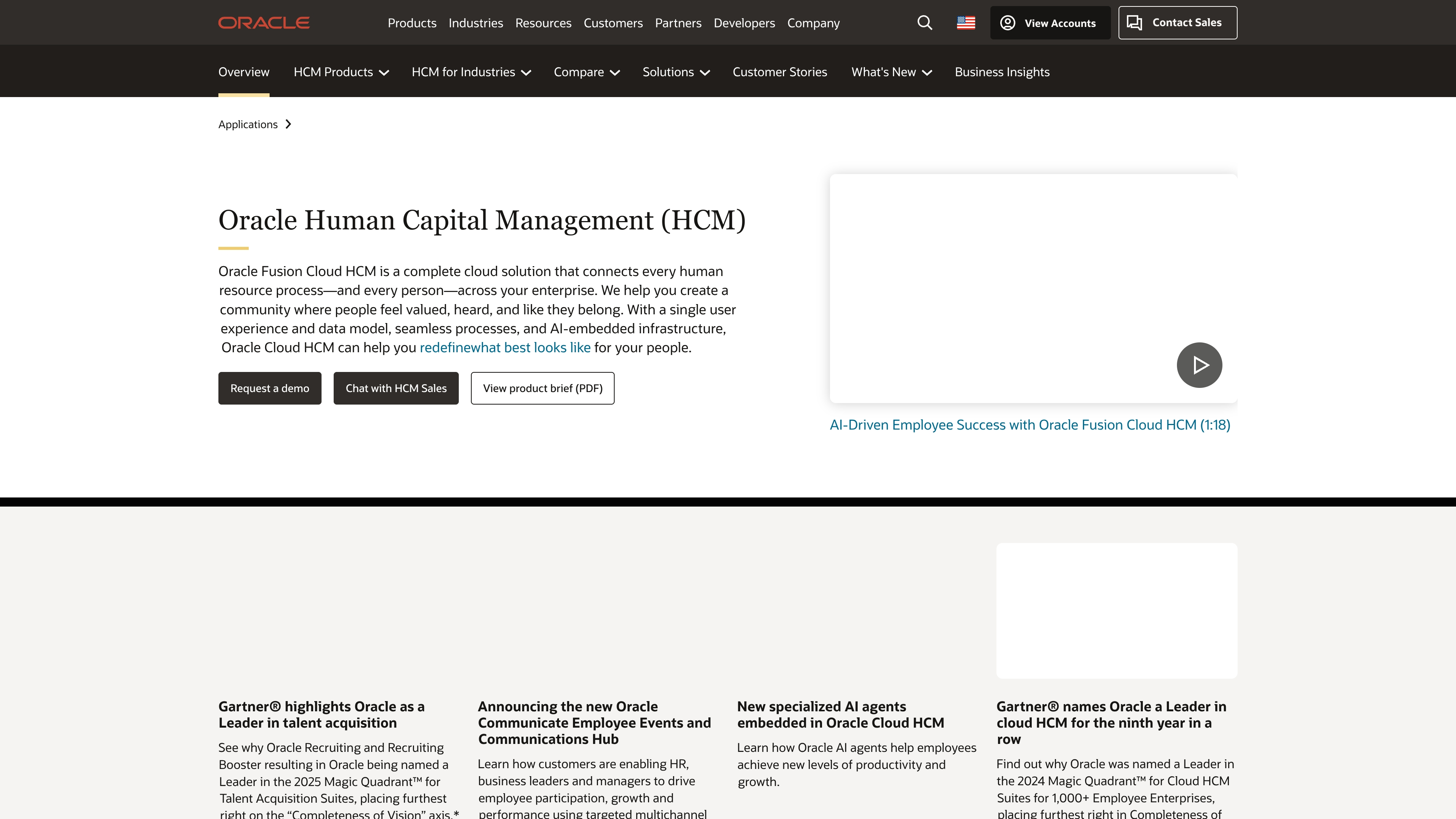
Use case: Enterprises seeking integrated succession planning and talent development at scale
Key features
- AI-powered candidate matching and “Best Fit” recommendations for succession roles
- Visual succession organization charts with readiness tracking and risk assessment
- Integrated talent pools and development planning with automated workflow capabilities
Pricing
Custom pricing available upon request.
Considerations
- Implementation complexity can be significant, often requiring specialized consultants and extended timelines
- Users report that succession planning modules may be less intuitive compared to other Oracle HCM features
4. Cornerstone OnDemand
Cornerstone OnDemand is a leading talent management suite designed to bring clarity and structure to your succession planning process. By integrating learning, performance, and succession into one unified platform, Cornerstone empowers organizations to proactively identify future leaders, visualize talent pipelines, and align employee growth with your evolving business needs.
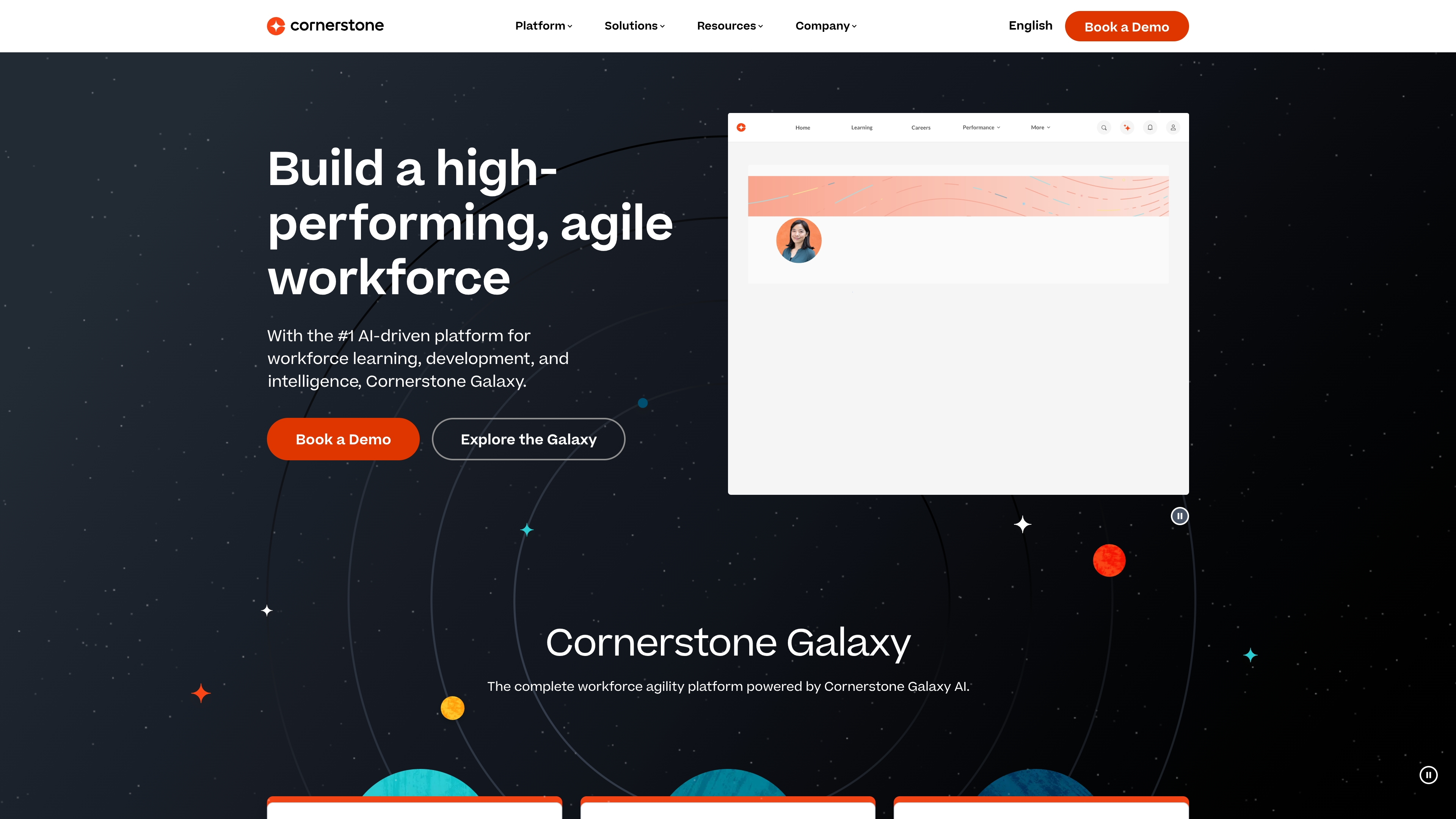
Use case: Organizations seeking to align learning initiatives with succession planning
Key features
- Talent pools with configurable grids and color-coding to visualize high-potential employees and succession readiness
- AI-powered Skills Graph technology for intelligent skills mapping and development planning
- Integrated development plans that connect learning modules directly to succession paths and career progression
Pricing
Custom pricing available upon request.
Considerations
- Platform complexity requires dedicated administrative resources and extensive training for effective implementation
- Higher cost structure may not be suitable for smaller organizations that don’t need the full suite of talent management features
5. Saba Cloud
Saba Cloud blends mentorship, social learning, and succession planning in a single platform, making leadership development a collaborative, ongoing journey — not a one-time event. By connecting talent growth to real-life projects and peer feedback, Saba helps you build a culture where future leaders emerge from every level of your organization.
Use case: Organizations focused on nurturing internal talent through structured mentorship and dynamic, peer-driven learning experiences
Key features
- AI-powered talent identification with configurable grids and color-coding to visualize high-potential employees and those at risk
- Integrated career development tools that connect learning activities directly to succession planning and performance goals
- Comprehensive talent pool management with readiness assessments and personalized development paths for future leaders
Pricing
Custom pricing available upon request.
Considerations
- Post-acquisition uncertainty regarding long-term product roadmap and feature development under Cornerstone ownership
- Complex user interface that some users find less intuitive compared to modern succession planning tools, potentially requiring additional training time
6. PeopleFluent
PeopleFluent is a comprehensive succession planning tool purpose-built for large enterprises that need to connect leadership development with real performance and growth data. Its approach is grounded in transparency and objectivity, giving you drag-and-drop scenario modeling, deep analytics, and intuitive talent mapping so you can build a leadership bench that’s ready for anything your business future holds.
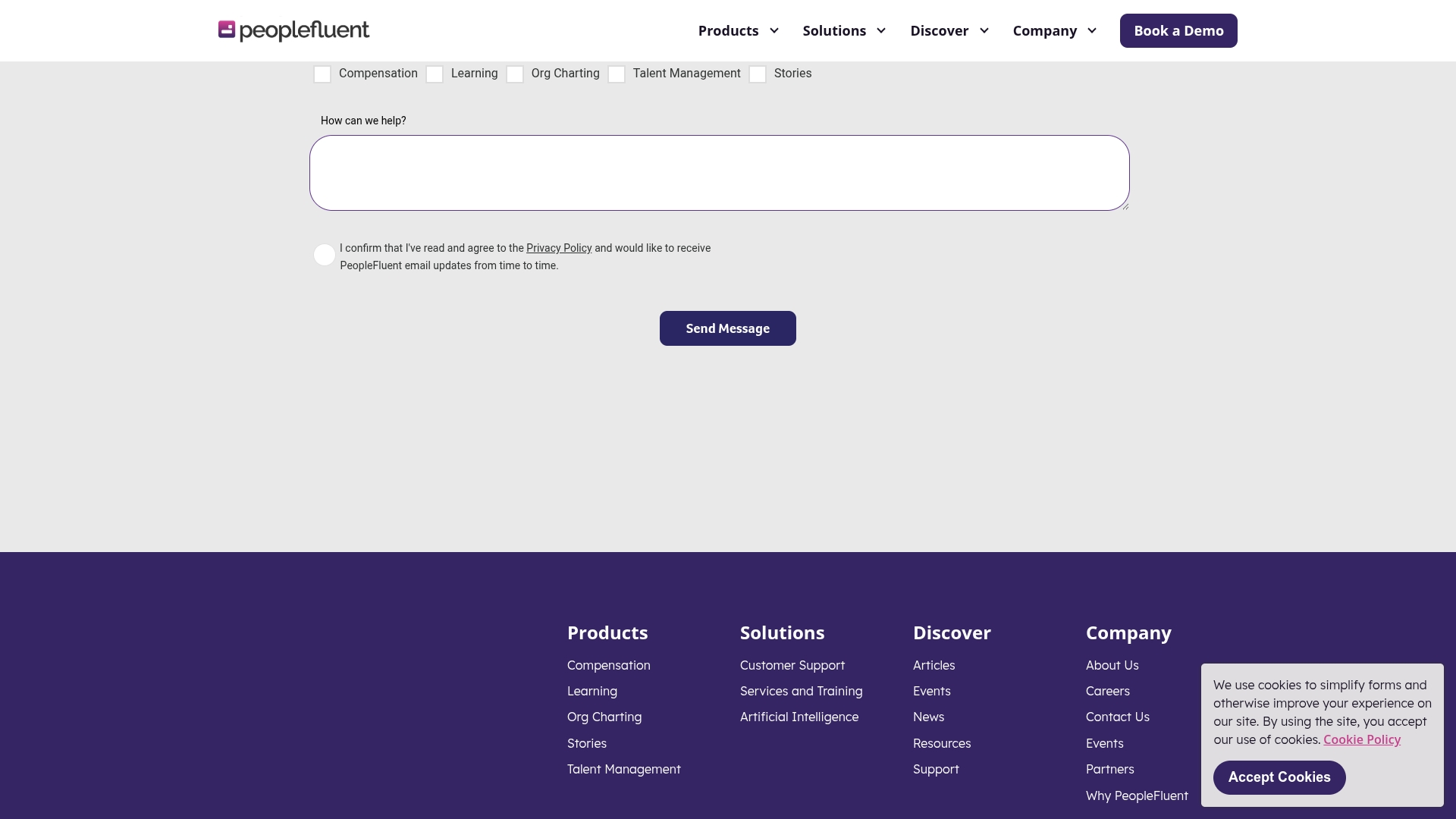
Use case: PeopleFluent helps large enterprises build robust leadership pipelines through integrated talent management that combines succession planning with performance data and learning development.
Key features
- Drag-and-drop succession scenario modeling with visual talent mapping capabilities
- Performance-potential grid (9-box) analysis for identifying high-potential employees
- Integrated career pathing that connects succession plans with personalized development programs
Pricing
Custom pricing available upon request.
Considerations
- User interface can feel outdated and complex to navigate for some team members
- Requires significant time investment to become proficient with the platform’s specialized features
7. UKG Pro
UKG Pro is an enterprise-grade human capital management platform that brings structure and foresight to succession planning. By integrating advanced analytics and talent insights, it helps organizations anticipate future needs and nurture internal talent for mission-critical roles, all within a unified HR ecosystem.
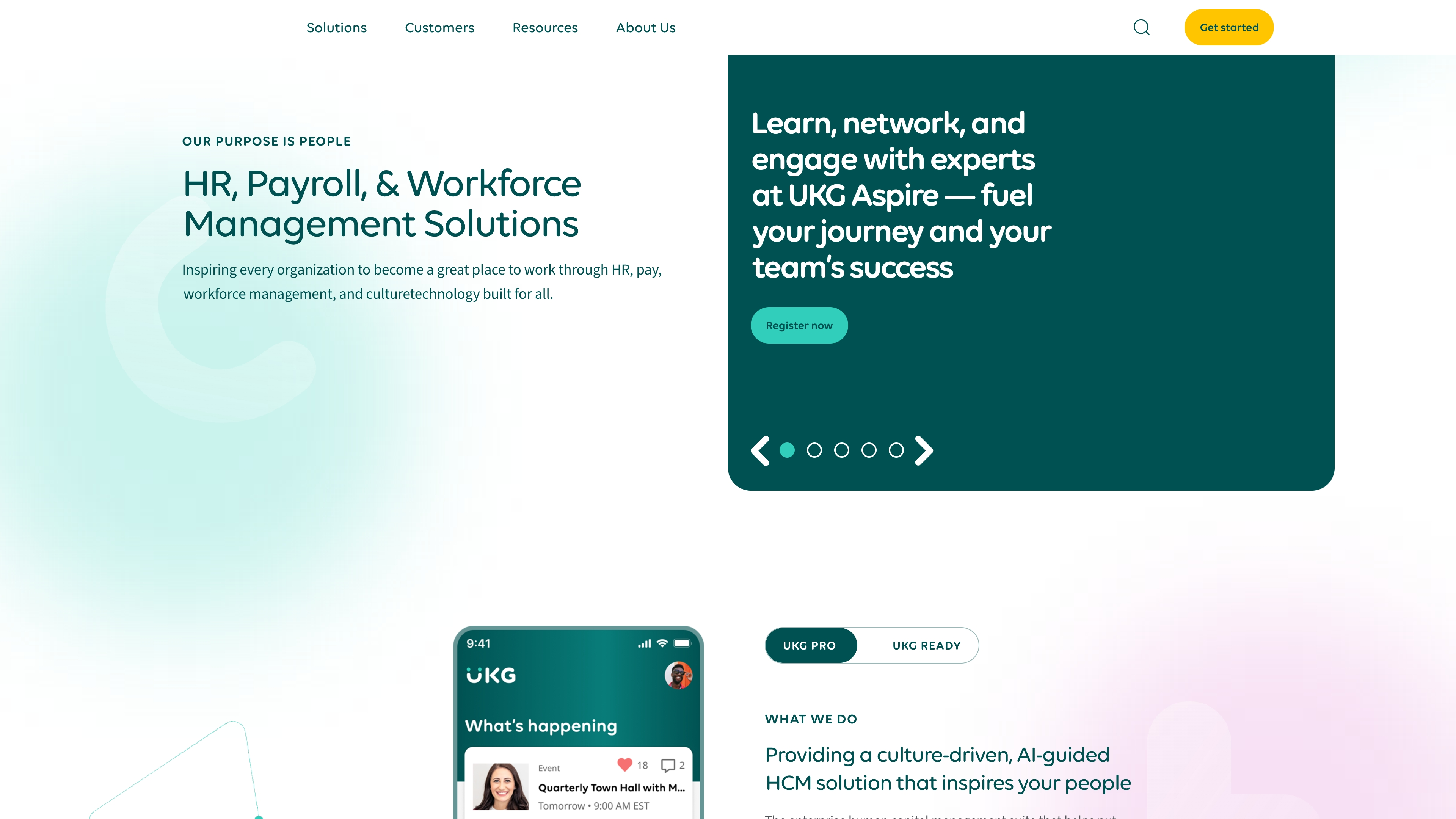
Use case: Enterprise businesses needing to identify successors and develop internal talent using AI-driven insights
Key features
- Predictive analytics and machine learning to identify high-potential candidates based on skills, experience, and performance data
- Individual development plans (IDPs) that create customized career paths aligned with organizational succession needs
- Talent profiles with comprehensive views of employee capabilities, readiness indicators, and succession potential
Pricing
Custom pricing available upon request.
Considerations
- Complex implementation process that can be overwhelming for organizations with limited HR resources
- High cost may not justify value for smaller businesses with basic succession planning needs
8. TalentGuard
TalentGuard brings structure to the often-chaotic world of succession planning. By harnessing AI and dynamic talent analytics, it equips organizations to proactively identify and nurture future leaders, turning potential risk into repeatable, strategic readiness.
Use case: Organizations looking to build leadership pipelines through AI-driven talent analytics and skills-based succession planning
Key features
- Unlimited customizable talent pools with automated candidate matching and readiness tracking
- AI-powered WorkforceGPT for intelligent role recommendations and skills gap analysis
- Risk mitigation center that identifies flight risks and succession gaps across the organization
Pricing
- Free trial: $0 for Competency Management Solution with no upfront commitment
- Custom pricing: Available for Automate, Engage, and Optimize bundles
Considerations
- User interface could benefit from modernization, though updates are actively in development
- Machine learning functionality is still in early stages, which may limit non-English language support
9. SuccessFinder
SuccessFinder is a science-driven succession planning solution that eliminates guesswork and bias, giving organizations a data-backed edge in identifying and developing future leaders. With deep behavioral assessments and objective analytics, SuccessFinder enables you to confidently match employees to the right leadership opportunities at every level.
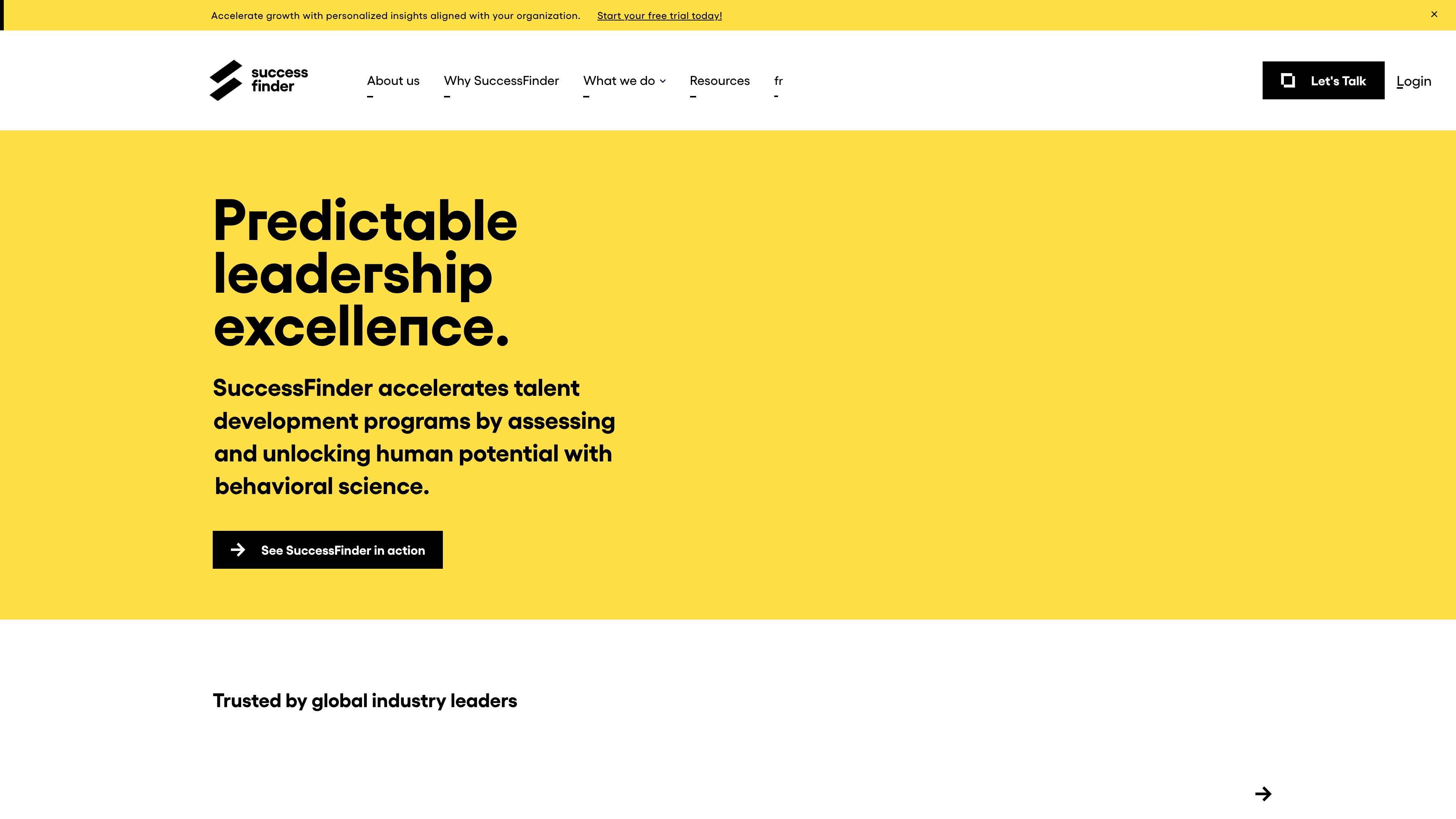
Use case: Organizations seeking scientifically-backed succession planning tools that eliminate bias and provide objective insights
Key features
- Behavioral DNA assessment measuring 85+ traits to create unique employee profiles
- Ladder of Leadership model that maps competencies required for different leadership levels
- High-potential identification system with predictive analytics for future role success
Pricing
Custom pricing available upon request.
Considerations
- Premium pricing may limit accessibility for smaller organizations with tighter budgets
- Comprehensive assessment depth can overwhelm users who aren’t familiar with detailed behavioral analytics
10. Plum
Plum is a modern succession planning platform that uses data-driven assessments to help organizations uncover and elevate future leaders from every department. By applying behavioral science and AI, Plum ensures you’re not just filling roles, but building a diverse talent pipeline that’s ready for tomorrow’s challenges.
Use case: Organizations looking to build diverse leadership pipelines through science-backed talent assessments
Key features
- AI-powered talent matching that connects employees to future roles based on behavioral competencies and cognitive abilities
- Leadership potential identification feature that surfaces future leaders regardless of their current title or tenure
- Talent rediscovery capabilities that allow companies to search their entire database of past and present candidates for internal mobility opportunities
Pricing
Custom pricing available upon request.
Considerations
- Pricing information isn’t publicly available, requiring engagement with sales team for cost assessment
- Some users recommend reviewing traditional resumes alongside Plum’s psychometric results for comprehensive candidate evaluation
11. ChartHop
ChartHop transforms static org charts into an interactive hub for succession planning, giving organizations a real-time, visual way to manage talent pipelines and anticipate future needs. Its scenario modeling and people analytics make it easy to spot skill gaps, model leadership changes, and ensure you’re always ready for what’s next. If you want to move from fragmented spreadsheets to a single, dynamic view of your workforce, ChartHop provides the clarity and control to keep your succession strategy on track.
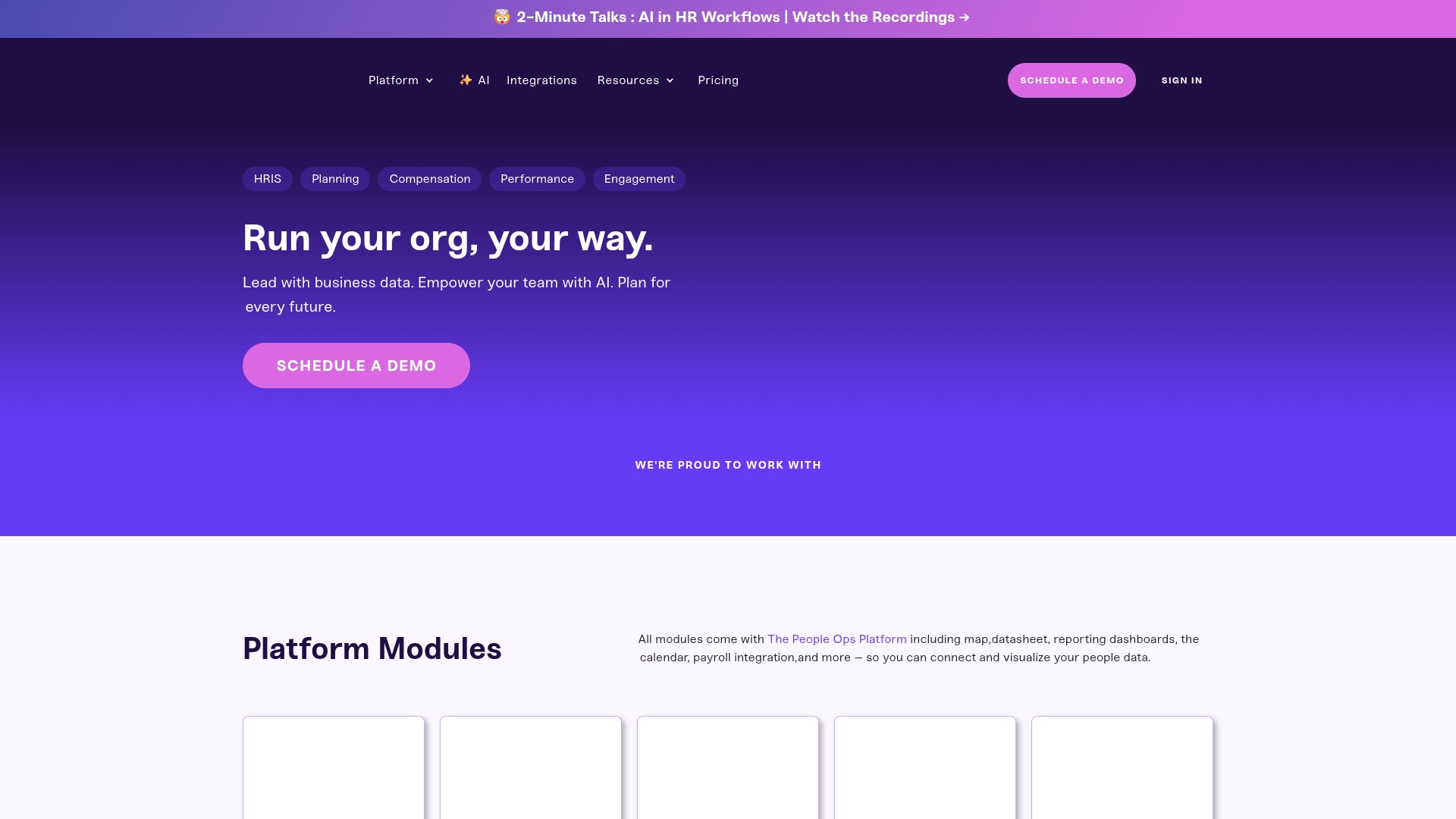
Use case: Organizations wanting to visualize their entire workforce structure and model succession scenarios in real-time
Key features
- Interactive organizational charts with “time travel” functionality to analyze historical changes and succession patterns
- Advanced scenario planning that lets you model promotions, backfills, and restructures before implementation
- Comprehensive people analytics that integrate performance data, skills mapping, and tenure insights for data-driven succession decisions
Pricing
- ChartHop Basic: $2/employee/month with no minimum contract or implementation fees
- ChartHop Platform: $8/employee/month for the first module, $4/employee/month for each additional module
- Minimum annual contract of $9,000 for Platform tier with separate implementation fees
Considerations
- The platform’s extensive features can feel overwhelming initially, requiring significant time investment to master all capabilities
- Lacks a dedicated succession planning module, instead relying on broader workforce planning tools that may not provide the structured workflows some organizations prefer
12. Lattice
Lattice is a modern people management platform that puts performance, growth, and succession planning all in one place. By connecting real-time performance data with career development insights, Lattice helps organizations spot tomorrow’s leaders early and map out clear, actionable growth paths. Its intuitive interface and robust analytics make it easy to keep your leadership pipeline strong, so you’re never caught off guard by a key departure.
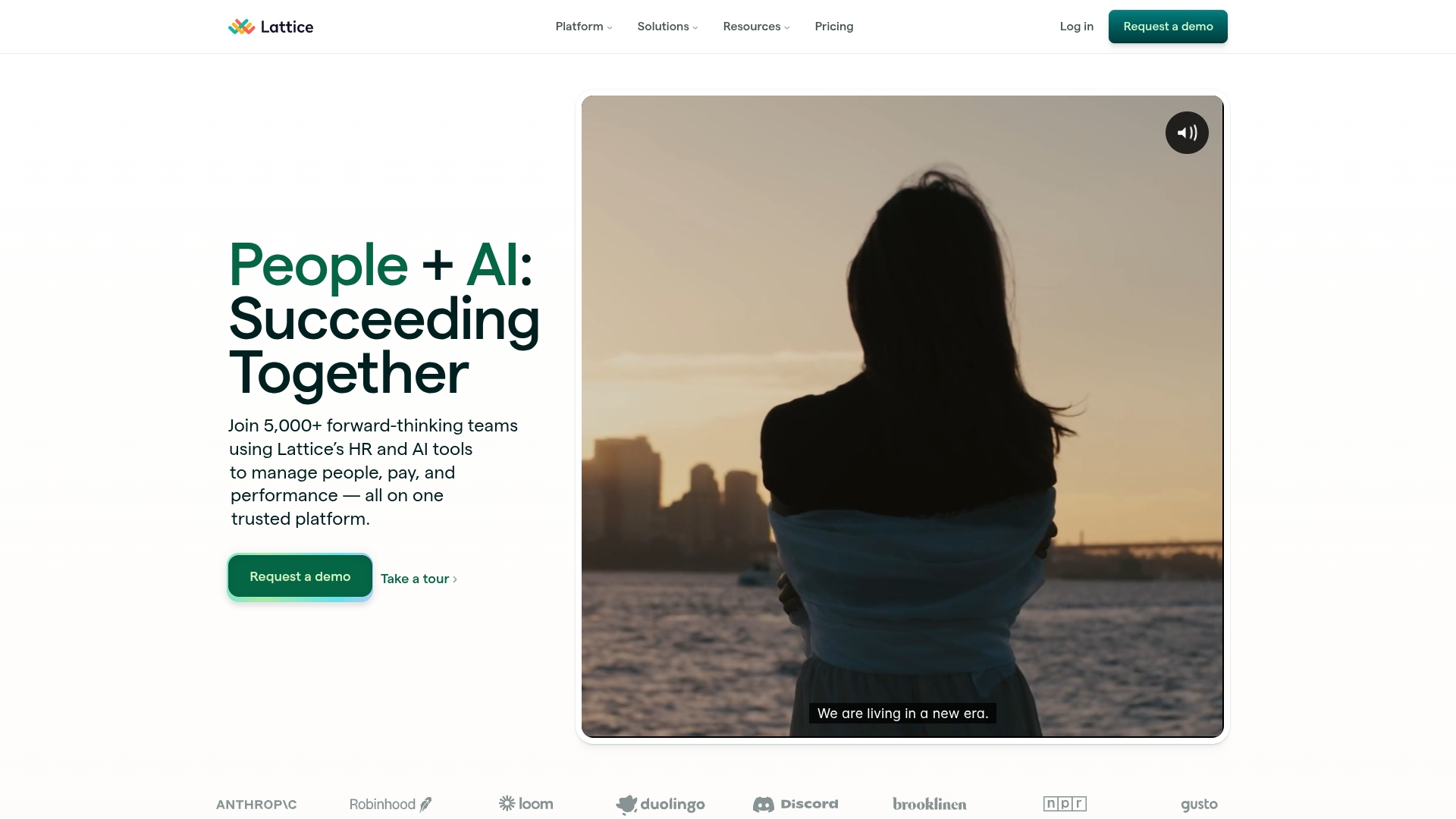
Use case: Organizations wanting to proactively identify and develop future leaders by seamlessly connecting performance data with succession readiness insights
Key features
- Talent reviews with 9-box grid plotting to identify high-potential employees based on performance and potential
- Career tracks that visualize advancement paths and required competencies for transparent succession planning
- Growth plans that create targeted development roadmaps linked to specific career progression goals
Pricing
- Talent Management (Foundations): $11/seat/month
- Core HRIS: $10/seat/month
- Add-on modules available for both packages
- Currently available for US-based businesses with limited UK beta testing
Considerations
- Succession planning features require multiple product subscriptions, which can increase overall costs
- May lack the depth needed for very large enterprises with highly complex succession planning requirements
13. Gloat
Gloat is a next-generation talent marketplace platform that reimagines succession planning by breaking down traditional hierarchies and unlocking hidden internal talent. Powered by AI, Gloat surfaces growth opportunities and connects employees to leadership roles based on skills, interests, and aspirations — giving organizations a dynamic, organization-wide approach to building their succession pipeline.
Use case: Large enterprises looking to build comprehensive succession plans by leveraging AI to identify and develop internal talent
Key features
- AI-powered talent matching that connects employees to leadership development opportunities based on skills and career aspirations
- Dynamic career pathing that maps personalized progression routes and identifies skill gaps for future roles
- Internal talent marketplace that provides visibility into workforce capabilities and promotes cross-functional mobility
Pricing
Custom pricing available upon request.
Considerations
- Less structured than traditional succession planning tools, focusing more on organic talent development through marketplace dynamics
- Platform effectiveness depends heavily on employee participation and profile completion to surface the right candidates
14. Fuel50
Fuel50 is a dynamic talent marketplace platform that redefines succession planning through continuous career pathing and skills development. By leveraging AI-driven insights, Fuel50 empowers organizations to identify high-potential talent, close skill gaps, and create personalized growth journeys for future leaders. This approach moves beyond traditional top-down planning, making employee development an ongoing, organization-wide strategy.
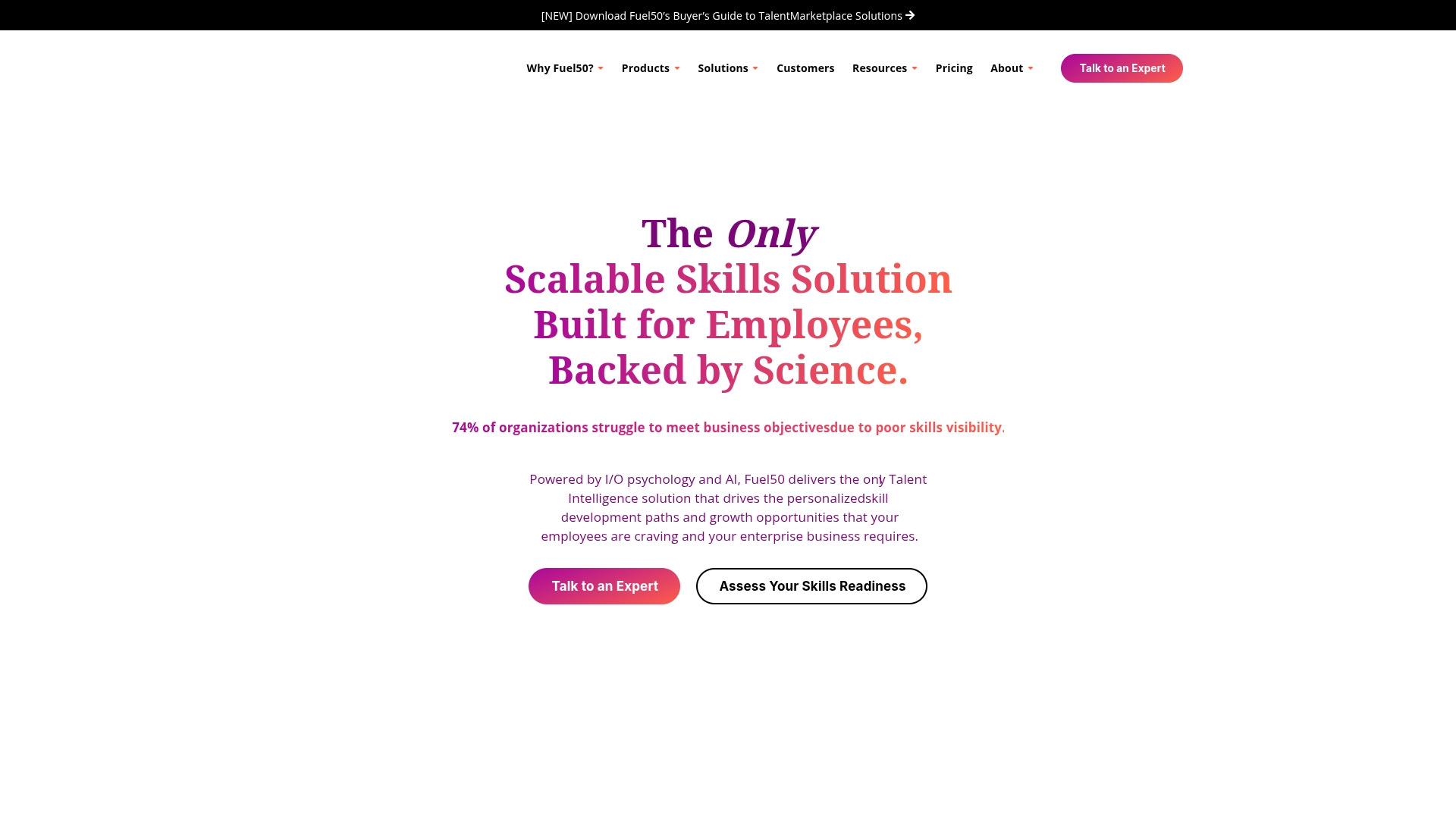
Use case: Businesses wanting to identify and develop potential successors through continuous career pathing and skills development
Key features
- AI-driven skills ontology that maps organizational capabilities and identifies potential successors based on actual skills, not just current roles
- Personalized career pathing with tailored development recommendations including courses, projects, and mentoring opportunities
- Skills gap analysis that compares potential successors’ capabilities with key position requirements to create targeted development plans
Pricing
Custom pricing available upon request.
Considerations
- The platform’s employee-centric approach may not suit organizations preferring traditional, manager-controlled succession planning workflows
- Full benefits require organization-wide adoption and active employee participation, which demands significant change management commitment
15. PerformYard
PerformYard brings succession planning and performance management together in one streamlined platform. Rather than relying on a separate module, organizations can weave succession planning directly into their regular review cycles, using real-time data to identify and prepare future leaders as part of everyday processes.
Use case: Organizations looking to build succession planning into their existing performance management processes
Key features
- Automated 9-box grid generation for visualizing employee performance and potential
- Customizable review cycles with 360-degree feedback and competency assessments
- Integrated goal management with cascading objectives aligned to organizational strategy
Pricing
- Performance Management: $5-10 per person per month (billed annually)
- Employee Engagement add-on: $1-3 per person per month when bundled
- Meetings and Surveys: $2-4 per person per month each when bundled
- All onboarding, training, and customer support included at no extra cost
- Enterprise discounts and minimum pricing available
Considerations
- No dedicated standalone succession planning module — requires building your own process using performance management tools
- Limited mobile functionality compared to some succession management software competitors
16. PageUp
PageUp brings clarity and strategy to succession planning by consolidating performance, learning, and talent data into a single, user-friendly platform. With its interactive tools and real-time insights, organizations can proactively identify future leaders and visualize bench strength across the business.
Use case: Organizations wanting to transform scattered talent data into strategic succession insights
Key features
- Interactive 9-box grid for drag-and-drop talent calibration and real-time succession discussions
- Talent pools and bench strength visualization with readiness tracking and risk assessment
- Employee profile management where team members outline skills, experience, and career aspirations
Pricing
Custom pricing available upon request.
Considerations
- Requires integration with separate HRIS systems as PageUp focuses on talent management rather than full HR functionality
- Some users report slower performance with reporting features and occasional integration challenges with existing HR software
17. Ascender
Ascender is a comprehensive talent management platform built for organizations operating across the Asia-Pacific region. Its succession planning tools help multinational companies navigate complex workforce structures, local compliance, and diverse cultural considerations while building a unified leadership pipeline. With real-time data integration and visual talent mapping, Ascender streamlines the process of identifying and developing future leaders at every level.
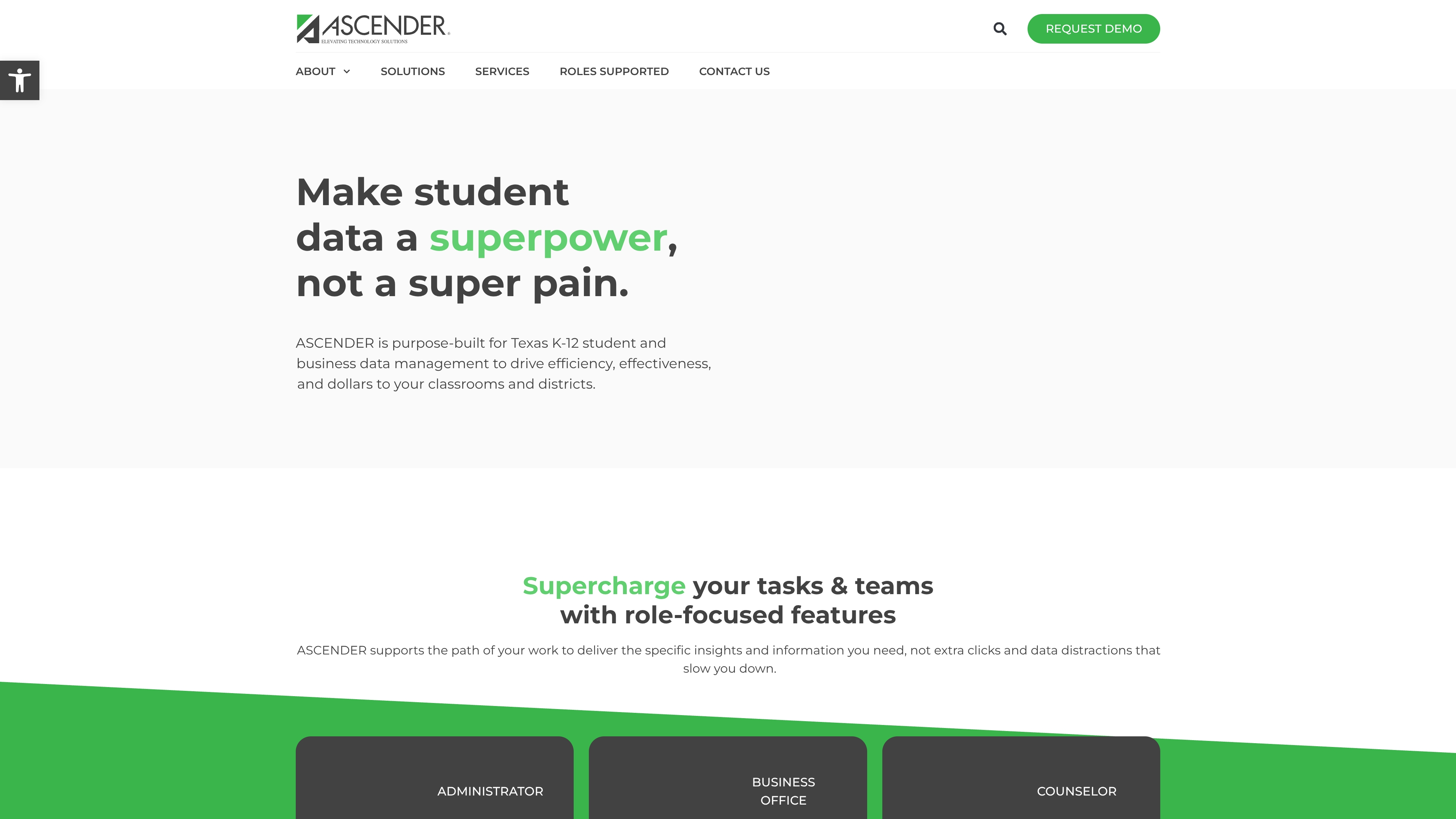
Use case: Multinational companies seeking to manage complex succession planning across multiple APAC countries while maintaining local compliance and cultural considerations
Key features
- Talent pools and succession matrices with visual 9-box grids for comparing employee performance against potential
- Real-time integration with payroll, performance, and learning data for comprehensive talent insights
- AI-powered career recommendations and flight risk monitoring to proactively address potential turnover
Pricing
Custom pricing available upon request.
Considerations
- Premium pricing may put it out of reach for smaller organizations with limited budgets
- The comprehensive platform can have a steep learning curve for new administrators
18. Talentsoft
Talentsoft delivers a flexible, Europe-focused talent management platform that streamlines succession planning, compliance, and employee development. By uniting talent pools, performance data, and automated insights, Talentsoft empowers organizations to confidently identify future leaders and ensure business continuity. Its intuitive tools support transparent decision-making and foster a culture of continuous growth.
Use case: European organizations seeking integrated talent management with robust succession planning capabilities and region-specific compliance features
Key features
- Talent Grid and Talent Box visualization tools for screening and assessing talent pools using customizable criteria
- Automated successor suggestions based on performance data, competencies, and career progression simulations
- Integrated performance management with continuous feedback loops and competency mapping for leadership development
Pricing
Custom pricing available upon request.
Considerations
- Implementation can be complex and time-consuming, requiring significant setup and customization effort
- Limited global market presence compared to larger competitors like SAP SuccessFactors and Workday
Best practices for implementing a succession planning program
Succession planning is more than a safety net; it is a strategic playbook for cultivating future leaders from within. This process turns the uncertainty of departures into an opportunity for growth by ensuring you always have confident, capable people ready to step up when the time is right.
Think of it as a focused effort to build your team’s bench strength. You are not just filling today’s roster but actively scouting and developing tomorrow’s all-stars, ensuring your organization is always prepared for its next big move.
Step 1: Map out a defined and fair process
Begin by defining which roles are most critical to your mission (aka those that would create the most significant disruption if left vacant). This establishes a transparent foundation built on objective criteria, not subjective feelings, so everyone understands the rationale behind the plan.
Enlist your leadership team as active champions, not just passive approvers. When they lead the initiative and participate in regular reviews, succession planning becomes a core operational discipline, not just another item on a checklist.
Step 2: Spot potential in every corner
Look beyond current performance to identify individuals with the potential to lead in the future. Utilize fair assessments and open nomination processes to uncover hidden gems, because your next great leader may not be the most obvious choice.
Actively challenge common biases that can inadvertently narrow your talent pool. The most vocal person in the room is not always the best strategist, so make a conscious effort to seek out diverse strengths and perspectives across all your teams.
Step 3: Create growth paths, not just training plans
One-size-fits-all training programs rarely produce lasting results. Instead, construct personalized development plans that blend mentorship, stretch assignments, and targeted learning to address specific skill gaps for each future leader.
Demonstrate your investment in their journey by creating real accountability around their growth. Regular check-ins and defined milestones keep development on track and transform good intentions into tangible progress.
Step 4: Track progress and keep everyone in sync
A great plan requires excellent visibility to succeed. Use a central system to monitor candidate progression, track milestones, and view development journeys so that nothing falls through the cracks.
This is where a platform like monday work management can unify your efforts. Centralize candidate data, automate progress updates, and leverage visual dashboards to provide every stakeholder with a real-time view of your leadership pipeline.
Try monday work managementStep 5: Stay agile and refine your plan
Your business is in a constant state of evolution, and your succession plan must be as well. Regularly measure key metrics — such as your internal promotion rate and the time it takes to fill key roles — to ensure your strategy remains aligned with your organizational goals.
Treat your program as a living system, not a static document. Use feedback from all participants to continuously iterate and improve, ensuring your plan grows stronger and smarter over time.
How to measure success with a succession planning platform
While creating a succession plan is the first step, tracking its impact is what builds a truly resilient organization. It marks the difference between hoping your future leaders are ready and knowing they are. This process isn’t about generating complex reports; it’s about gaining the insight needed to make confident decisions about your company’s future.
To achieve that clarity, concentrate on the vital signs of your talent pipeline: readiness, retention, and risk. You must understand how prepared your bench is, whether your top talent is engaged and committed, and where a surprise departure would leave you most exposed. Answering these questions elevates succession planning from a theoretical exercise to a powerful strategic advantage.
Bring these critical metrics to life on a single, visual platform like monday work management. Instead of digging through spreadsheets for answers, your team gets a real-time view of your leadership pipeline, helping you spot gaps, celebrate progress, and prove the value of your talent strategy. It’s about transforming scattered data into streamlined execution, so you can build your future workforce with confidence.

Take your leadership pipeline to the next level
Waiting for a key player to depart before searching for a replacement is a formula for disruption. A robust leadership pipeline is not just about filling gaps; it’s about proactively building your team’s future, one leader at a time. This is the strategy that keeps the best teams ahead of change.
Your playbook begins with mapping out critical roles and identifying high-potential talent ready for their next challenge. This isn’t a static org chart but a living strategy that aligns individual growth with your company’s most important goals. You are building a bench of talent that is always ready.
Try monday work managementFAQs
How does AI impact succession planning software?
AI impacts succession planning software by using data to objectively identify high-potential candidates and predict future leadership gaps. It automates manual assessments, freeing up your team for more strategic work.
Can smaller organizations benefit from succession planning platforms?
Yes, because the impact of losing one key person is much greater in a smaller company. These tools are scalable and allow you to start by focusing only on your most critical roles.
What is the difference between succession planning and talent management software?
Succession planning software focuses specifically on identifying and developing future leaders for key roles. Talent management is a broader platform covering the entire employee lifecycle, from recruiting to performance reviews.
How often should succession plans be reviewed and updated?
Review plans for your most critical positions quarterly to stay agile. A full, comprehensive plan update should be completed annually.
What role do skills assessments play in effective succession planning?
They provide objective data on an employee's readiness, revealing specific gaps between their current skills and what a future role requires. This allows for targeted, effective development plans instead of guesswork.
How can companies measure the ROI of succession planning software?
You measure ROI primarily through reduced hiring costs and faster time-to-fill for leadership roles by promoting from within. Additional value comes from higher retention of top talent and smoother leadership transitions.
